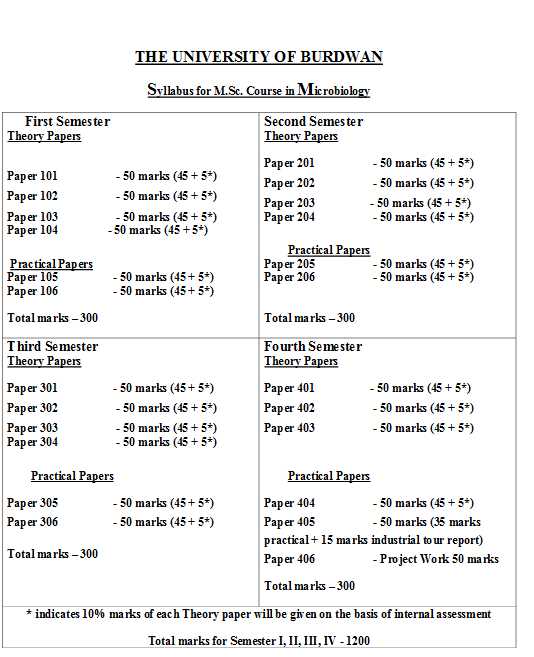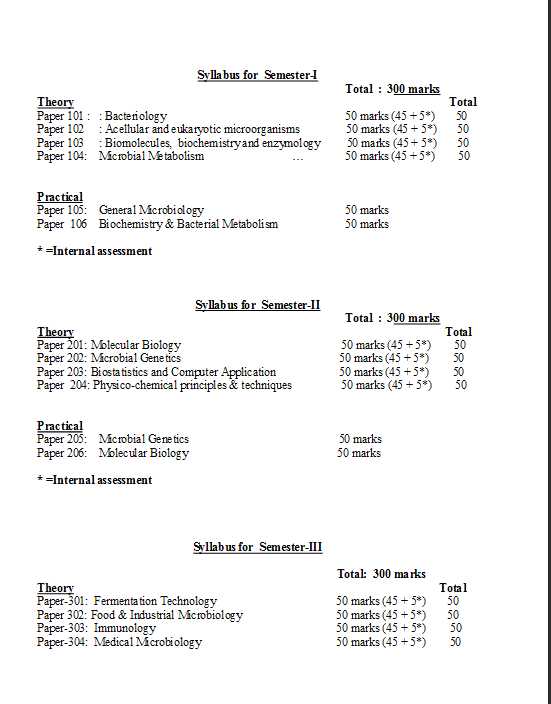|
#1
May 20th, 2015, 10:44 AM
| |||
| |||
| Burdwan University M Sc Microbiology Syllabus
Has the syllabus of M.Sc. course in Microbiology at Burdwan University revised this time as it was rumored last year? Provide me the syllabus of M.Sc. Course in Microbiology of Burdwan University in PDF format? There are total 4 semesters in M Sc Microbiology Course. Duration of this Course is 2 Years. As you are looking for syllabus of M Sc Microbiology Course offered by Burdwan University, so here I am providing complete syllabus: Burdwan University M Sc Microbiology Syllabus Semester I Theory Papers Paper 101 - 50 marks (45 + 5*) Paper 102 - 50 marks (45 + 5*) Paper 103 - 50 marks (45 + 5*) Paper 104 - 50 marks (45 + 5*) Practical Papers Paper 105 - 50 marks (45 + 5*) Paper 106 - 50 marks (45 + 5*) Semester II Theory Papers Paper 201 - 50 marks (45 + 5*) Paper 202 - 50 marks (45 + 5*) Paper 203 - 50 marks (45 + 5*) Paper 204 - 50 marks (45 + 5*) Practical Papers Paper 205 - 50 marks (45 + 5*) Paper 206 - 50 marks (45 + 5*) Semester III Third Semester Theory Papers Paper 301 - 50 marks (45 + 5*) Paper 302 - 50 marks (45 + 5*) Paper 303 - 50 marks (45 + 5*) Paper 304 - 50 marks (45 + 5*) Practical Papers Paper 305 - 50 marks (45 + 5*) Paper 306 - 50 marks (45 + 5*) Semester IV Fourth Semester Theory Papers Paper 401 - 50 marks (45 + 5*) Paper 402 - 50 marks (45 + 5*) Paper 403 - 50 marks (45 + 5*) Practical Papers Paper 404 - 50 marks (45 + 5*) Paper 405 - 50 marks (35 marks practical + 15 marks industrial tour report) Paper 406 - Project Work 50 marks SEMESTER I PAPER 101 – BACTERIOLOGY 1. History and major events in the development of microbiology (1 L) 2. Origin of life, Prokaryotic diversity, theory of endosymbiogenesis. Prokaryotic taxonomy- classical and modern. Prokaryote and eukaryote species concept.(7 L) 3. Morphology and structure : Morphological types, cell walls of Gram positive, Gram negative, archaea and eukaryotic micro organisms and L-forms ; antigenic properties of cell wall ; capsule types, composition and function ; cell membrane ; structure composition and properties.(7 L) 4. Function of flagella, Pili, Fimbriae; Phototaxis, magnetotaxis. (3L) 5. Control of bacteria: Physical, chemical and biological control. (4 L) 6. Maintenance of microbial culture: Principles and techniques. (2 L) 7. Perennating bodies- Cysts, myxospores with special references to endosporogenesis, their structure; ecological significance of such perennating bodies.(3 L) 8. Cell cycle, cell division, binary fission, multiple fission, budding. (2 L) 9. Cultivation of bacteria: Nutritional types, culture media used; kinetics, aerobic and anaerobic cultures, synchronous and asynchronous culture, batch, fed batch and continuous culture. Measurement of growth, factors affecting growth. (5L) 10. Archaea: General characters including membrane and cell wall.(2) 11. Extreamophiles: halophiles, thermophiles, psychrophiles, mechanisms of resistance, alkalophiles and acidophiles. (6L) 12. General account of major groups of bacteria like Spirochetes, Mycoplasmas, Actinomycetes, Rickettsias, Chlamydias, Myxobacteria, Cyanobacteria, Prochlorones, Cyanales. (8 L) PAPER-102 ACELLULAR AND EUKARYOTIC MICROORGANISMS 1. Micro algae: Diversity, distribution, nutrition, mode of reproduction, ecological significance, phycotoxins, economic importance including role in human affairs.(6 L) 2. Fungi: Diversity, modes of reproduction, ecological significances, economic importance, sex hormones, mycotoxins, fungal associations with plants, animals and humans,.(6 L) 3. Protozoa: Diversity, reproduction, classification, importance to human affairs.(3 L) 4. Helminthes: General account, reproduction, classification, importance.(3 L) 5. History and development of virology, distinctive, properties of virus, morphology, architecture, capsid arrangement, types of envelope and their composition.(5 L) 6. Viral nomenclature, classification of virus including Baltimore’s classification, assay of virus – plant, animal and bacteriophage, (5 L) 7. Transmission of plant, animal and bacterial viruses.(2 L) 8. Viral nucleic acid types, replication of viral DNA and RNA types.(4 L) 9. Variations in structure of bacteriophages, lytic cycle of bacteriophages with reference. (7 L) 10. Lysogeny: molecular mechanism of lytic-lysogenic conversion, significance.( 2 L) 11. Life cycles and replication of Ebola virus, Cauliflower Mosaic Virus, Mimi virus, Potato Spindle virus. (5 L) 12. Prions, Viroids and Virusoids.(2 L) PAPER 103 - BIOMOLECULES, BIOCHEMISTRY & ENZYMOLOGY 1. Concept of chemical interactions such as covalent, hydrogen, and dihedral bond; electrostatic, hydrophobic and Vanderwaals interaction in biological system.(2 L) 2. Physical properties of water, structure of water molecules, weak interactions in aqueous solution, Ionization of water, Bronsted – Lowry concept of acid and bases, concept of pH and Buffer, Henderson – Hasselbatch equation, biological buffer system (4 L) 3. Carbohydrates: Classification, asymmetry, optical isomerism, mutarotation, homo and hetero-polysaccharides. (4 L). 4. Amino acids: Nature (Non-polar, polar, neutral, acidic basic) specific rotation, electrochemical properties, iso-electric properties, non-protein amino acids, absorption in UV-range (4 L). 5. Proteins: Classification of proteins, primary, secondary, tertiary and quaternary structure, Ramchandran plot. Classification based on functions ; enzyme, storage, regulatory, transport protein, classification based on composition, based on molecular shape ; globular, fibrous, determination of N- and C- terminals, protein folding and denaturation of proteins, purification of proteins, assessment of purity of protein. Protein sequencing. (7 L). 6. Nucleic acids : Physical properties of DNA and RNA, structure of DNA and RNA, double helical A-form, B-form, Z-form of DNA, DNA denaturation and renaturation, DNA super coiling, bonding pattern of DNA, DNA sequencing (5 L). 7. Lipids and cell membrane: Nomenclature, classification, properties, membrane structure (4 L). 8. Vitamins and co-enzymes: water soluble vitamins and their co-enzymes, lipid soluble vitamins; metal co-factors (3 L). 9. Thermodynamics in biology : heat, work, energy – first law of thermodynamics & molecular interpretation of thermodynamic quantities, entropy, enthalpy, free energy & equilibrium, 2nd law of thermodynamics in relation to cell function (5 L). 10. Enzymes : Classes of enzymes ; active and binding sites; co-enzymes, co-factors, holo and apoenzymes, enzyme activity, units; enzyme inhibitors and activators, enzyme kinetics – Michaelis –Menten derivation, km values, association and dissociation constant, inhibition and its kinetics, effect of pH and temperatures on enzymes action, enzyme regulation, allosteric, covalent modification, isoenzyme, abzymes, ribozymes other non-protein biocatalysts (12 L). Burdwan University M Sc Microbiology Syllabus   Last edited by Neelurk; May 15th, 2020 at 10:18 AM. |